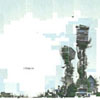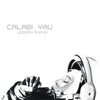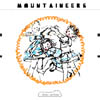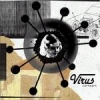 All the light-weight electronics and smeared melody runs make me thinkof the ocean pushing up against the beach this past year. All thesounds suggest a simple tinkering, something happening just under asheet of roaring noise that somehow stops roaring and goes into acocoon to emerge as a whisper. Children are running all over the place,too, and it's not that they're making a mess, but I'll be damned ifthey don't seem way more busy than they should be capable of.Everything's a little simplified on Pinaforeand that being so, I have a difficult time feeling anything butnostalgic when this is spinning. The sounds are piled one on anotherand it's very easy to capture every little second of music in my headand let it push its full effect on me. The record, I'm afraid to say,almost made me just a little sad. I couldn't help but think of theCalifornia beach and the way the water sounds when its crashing intorocks and the way, despite that incredible wall of sound, that thebirds, the wind, and the people's voices around me were crystal clear.I make it sound as if Illoin writes noise-inspired music, buteverything is very subtle: all the drums click and clack and sort ofstutter underneath pillows while bass melodies swindle their way out ofa little kid's toys. It makes me want to dance a little bit, but thatmelancholy is a strong presence. The lonly piano of "Pinafore" and theringing and delicate raindrops on "Darkwater" drag me under and intomemory and its a strong presence to be in the company of when musicmakes it so visceral. I was watching it snow outside while I listenedto this record, too, and it was a soft snow-fall. The music almostseemed to mimic the way the snow fell and was whipped about by thewind. This is a stark and simultaneously lush collection of songs thathas stayed in my player since I received it.
All the light-weight electronics and smeared melody runs make me thinkof the ocean pushing up against the beach this past year. All thesounds suggest a simple tinkering, something happening just under asheet of roaring noise that somehow stops roaring and goes into acocoon to emerge as a whisper. Children are running all over the place,too, and it's not that they're making a mess, but I'll be damned ifthey don't seem way more busy than they should be capable of.Everything's a little simplified on Pinaforeand that being so, I have a difficult time feeling anything butnostalgic when this is spinning. The sounds are piled one on anotherand it's very easy to capture every little second of music in my headand let it push its full effect on me. The record, I'm afraid to say,almost made me just a little sad. I couldn't help but think of theCalifornia beach and the way the water sounds when its crashing intorocks and the way, despite that incredible wall of sound, that thebirds, the wind, and the people's voices around me were crystal clear.I make it sound as if Illoin writes noise-inspired music, buteverything is very subtle: all the drums click and clack and sort ofstutter underneath pillows while bass melodies swindle their way out ofa little kid's toys. It makes me want to dance a little bit, but thatmelancholy is a strong presence. The lonly piano of "Pinafore" and theringing and delicate raindrops on "Darkwater" drag me under and intomemory and its a strong presence to be in the company of when musicmakes it so visceral. I was watching it snow outside while I listenedto this record, too, and it was a soft snow-fall. The music almostseemed to mimic the way the snow fell and was whipped about by thewind. This is a stark and simultaneously lush collection of songs thathas stayed in my player since I received it.
Two new shows just for you. We have squeezed out two extended release episodes for this weekend to get you through this week. They contain mostly new songs but there's also new issues from the vaults. The first show features music from Rider/Horse, Mint Field, Robert Aiki Aubrey Lowe, Anastasia Coope, ISAN, Stone Music, La Securite, Bark Psychosis, Jon Rose, Master Wilburn Burchette, Umberto, Wand, Tim Koh, Sun An, and Memory Drawings. The second episode has music by Laibach, Melt-Banana, Chuck Johnson, X, K. Yoshimatsu, Dorothy Carter, Pavel Milyakov, Violence Gratuite, Mark Templeton, Dummy, Endon, body / negative, Midwife, Alberto Boccardi, Divine. Cow in Maui from Veronika in Vienna. Get involved: subscribe, review, rate, share with your friends, send images! |



 The first release by the Chinese Stars is a no frills romp with moxy tospare, a post-punk garage tirade that refuses to relent, and a tooshort visit from a friend you miss only after he's been gone longenough to forget what you didn't like. At fourteen-and-a-half minutesand five tracks, it's just a taste, and some may see that as a goodthing. This is music for the mentally ill, made by the mentally ill,and every sloppy minute of it is another godsend. Former members of SixFinger Satellite and Arab on Radar make up the Stars, and their CD cutinto the shape of one of the implements with which they share theirname. Lyrics like "You could build a bone toilet with the calories thatroll off your shoulder" and "I was grew up in a glue factory/my teenageyears were less than satisfactory" pepper the release, yet Eric Paulsings "Now, I worry about you" as if everyone else has a problem buthe's fine. The ugly crunch of the guitar and the pounding drums — withcowbell that would make Christopher Walken proud in areas — do nothingbut feed this perversion, but at the end it's all in good fun. I couldnot resist tapping my foot, and though abrasive it may be as theguitars squeal to bleed the eardrums, this EP is jolly fun to listen toand rolls right along like it would run anything over if it got intheir way. It's a fantastic primer for what the band is capable of, andit serves as a warning in a way: these Chinese Stars are dangerous, andnot to be trifled with.
The first release by the Chinese Stars is a no frills romp with moxy tospare, a post-punk garage tirade that refuses to relent, and a tooshort visit from a friend you miss only after he's been gone longenough to forget what you didn't like. At fourteen-and-a-half minutesand five tracks, it's just a taste, and some may see that as a goodthing. This is music for the mentally ill, made by the mentally ill,and every sloppy minute of it is another godsend. Former members of SixFinger Satellite and Arab on Radar make up the Stars, and their CD cutinto the shape of one of the implements with which they share theirname. Lyrics like "You could build a bone toilet with the calories thatroll off your shoulder" and "I was grew up in a glue factory/my teenageyears were less than satisfactory" pepper the release, yet Eric Paulsings "Now, I worry about you" as if everyone else has a problem buthe's fine. The ugly crunch of the guitar and the pounding drums — withcowbell that would make Christopher Walken proud in areas — do nothingbut feed this perversion, but at the end it's all in good fun. I couldnot resist tapping my foot, and though abrasive it may be as theguitars squeal to bleed the eardrums, this EP is jolly fun to listen toand rolls right along like it would run anything over if it got intheir way. It's a fantastic primer for what the band is capable of, andit serves as a warning in a way: these Chinese Stars are dangerous, andnot to be trifled with. It seems like an eternity since the release of Suchy's third album, Entskidoo,easily one of my favorites from last year. The record felt like thefirst major statement from the German guitarist-turned-laptopper,beautifully representing his skills over two seamless sides, eachteeming with layers of pixilated guitar noise that coalesce to createsomething wholly other. Suchy makes psychedelia for the digital age, aremarkably streamlined combination of hypnotic, half-improvised guitarlines and an equally absorbing array of electronic sounds. His guitartalent is matched only by his ability to integrate it with the rest ofhis often busy, though never confused compositions. The sound ofSuchy?s guitar becomes automated rattle, static drone, windchime, eventhe wind itself, until enjoying it means slipping into a kind of trancestate, swaying at Suchy's whim. Calabi.Yau is less noisy andless colorful than its predecessor but is equally rich in both sonicdensity and hallucinatory power. Suchy keeps plenty of melody at hand,though here it is pushed further from the core of the songs, which relymore on shivering feedback and scattered plucking and tinkering toachieve their desired effects. When melody does enter, it comes with anaura of detachment, a hesitance to make too bold a stroke. Where Entskidoo was like a journey through the tropics or some mutant jungle, Calabiis colder and more spacious. Even "Ka-asam," the disc's most raucouslypsychedelic track, arrives through a background of weightless drones,floating in on choppy waveforms like transmissions of a distantsatellite. The new addition of Stephen Barnickel's percussioncontributes ominous gong-like roars to Suchy's frequently gorgeouspicked sections, and various clatter to the more abstract parts, addingtangible, or at least recognizable touches to the guitarist'sincreasingly bizarre soundscapes. I've always thought it a mystery whySuchy is so rarely grouped among other electronic or experimentalartists using guitars, like Fennesz or Christopher Willits. Though witheach new release, Suchy gives me the easy answer: he operates on acompletely elevated plain. The production value and nuance of thisrecord places it on par with any from the aforementioned musicians, butthe complexity of Suchy's arrangements, the emotional and illusionistdistance covered by each track, remains unmatched.
It seems like an eternity since the release of Suchy's third album, Entskidoo,easily one of my favorites from last year. The record felt like thefirst major statement from the German guitarist-turned-laptopper,beautifully representing his skills over two seamless sides, eachteeming with layers of pixilated guitar noise that coalesce to createsomething wholly other. Suchy makes psychedelia for the digital age, aremarkably streamlined combination of hypnotic, half-improvised guitarlines and an equally absorbing array of electronic sounds. His guitartalent is matched only by his ability to integrate it with the rest ofhis often busy, though never confused compositions. The sound ofSuchy?s guitar becomes automated rattle, static drone, windchime, eventhe wind itself, until enjoying it means slipping into a kind of trancestate, swaying at Suchy's whim. Calabi.Yau is less noisy andless colorful than its predecessor but is equally rich in both sonicdensity and hallucinatory power. Suchy keeps plenty of melody at hand,though here it is pushed further from the core of the songs, which relymore on shivering feedback and scattered plucking and tinkering toachieve their desired effects. When melody does enter, it comes with anaura of detachment, a hesitance to make too bold a stroke. Where Entskidoo was like a journey through the tropics or some mutant jungle, Calabiis colder and more spacious. Even "Ka-asam," the disc's most raucouslypsychedelic track, arrives through a background of weightless drones,floating in on choppy waveforms like transmissions of a distantsatellite. The new addition of Stephen Barnickel's percussioncontributes ominous gong-like roars to Suchy's frequently gorgeouspicked sections, and various clatter to the more abstract parts, addingtangible, or at least recognizable touches to the guitarist'sincreasingly bizarre soundscapes. I've always thought it a mystery whySuchy is so rarely grouped among other electronic or experimentalartists using guitars, like Fennesz or Christopher Willits. Though witheach new release, Suchy gives me the easy answer: he operates on acompletely elevated plain. The production value and nuance of thisrecord places it on par with any from the aforementioned musicians, butthe complexity of Suchy's arrangements, the emotional and illusionistdistance covered by each track, remains unmatched. Continuing the time-honored tradition of reissuing widely availableback albums instead of releasing new music, Current 93 present aremastered, repackaged and expanded 2CD re-release of 1991's Thunder Perfect Mind. In contrast to some recent, mostly pointless rehashes of the back catalog, TPMwas due for this treatment, as the original CD issue was poorlymastered. The volume was far too low and the mix lacked punch, inferiorto the hard-to-find LP edition. The bonus disc is comprised of TPM-era outtakes, alternate versions and live material. Nearly all of this material can also be found on Emblems: The Menstrual Years and Calling For Vanished Faces,so Current 93 collectors will find very little that is attractive aboutthis package, with the exception of the restored LP cover artwork andthe nifty foldout digipack. Of course, the music on Thunder Perfect Mind is nothing less than essential, the first entry in David Tibet's masterful three-album run that also included the classics Of Ruine or Some Blazing Starre and All The Pretty Little Horses. With TPM,David Tibet created his first highly personal tour de force, asprawling double album that finally gelled all of Tibet's myriadinfluences - esoteric, lyrical and musical - and represented the veryculmination of his promising, though uneven early career. Thunder Perfect Mindis that rare class of albums where every track is a highlight - thecrisp medieval balladry and bizarre Gnostic cosmology that comprise"The Descent of Long Satan and Babylon," the melancholic funeral dirgeof "A Song for Douglas After He's Dead," the atmospheric gloom of "ASadness Song" and the swirling, spectral psychedelia of "All The StarsAre Dead Now." The collaborations on TPM are among Current 93'sfinest: Jhon Balance's vocals on "Rosy Star Tears From Heaven" pushesthe track into the kind of Satanic fury previously only heard on Comus'First Utterance, and Bevis Frond's Nick Salomon contributes anelectrifying third-eye guitar track to the side-long prophetic Blakeanhallucinations of "Hitler as Kalki (SDM)." David Tibet and producerSteven Stapleton transform holophonic krautrocker Sand's skeletal "WhenThe May Rain Comes" into a masterpiece of phased Euro-folk, evoking thewet cobblestones of a half-remembered old-world Berlin. A true rarityin the Current 93 canon, the outtakes from TPM are every bit asgood as the album, especially "Maldoror Is Ded Ded Ded Ded" and "TheyReturn To Their Earth" - a pair of stunning tracks that build to afrighteningly cathartic climax. The re-mastering job is admirable,raising the volume and adding dimension to the high and lowfrequencies, without sacrificing the integrity of the original'sfidelity. This is exactly what I hope for when a favorite of mine isre-issued - a superbly realized package that deepens, rather thandilutes my conviction that the album is a classic.
Continuing the time-honored tradition of reissuing widely availableback albums instead of releasing new music, Current 93 present aremastered, repackaged and expanded 2CD re-release of 1991's Thunder Perfect Mind. In contrast to some recent, mostly pointless rehashes of the back catalog, TPMwas due for this treatment, as the original CD issue was poorlymastered. The volume was far too low and the mix lacked punch, inferiorto the hard-to-find LP edition. The bonus disc is comprised of TPM-era outtakes, alternate versions and live material. Nearly all of this material can also be found on Emblems: The Menstrual Years and Calling For Vanished Faces,so Current 93 collectors will find very little that is attractive aboutthis package, with the exception of the restored LP cover artwork andthe nifty foldout digipack. Of course, the music on Thunder Perfect Mind is nothing less than essential, the first entry in David Tibet's masterful three-album run that also included the classics Of Ruine or Some Blazing Starre and All The Pretty Little Horses. With TPM,David Tibet created his first highly personal tour de force, asprawling double album that finally gelled all of Tibet's myriadinfluences - esoteric, lyrical and musical - and represented the veryculmination of his promising, though uneven early career. Thunder Perfect Mindis that rare class of albums where every track is a highlight - thecrisp medieval balladry and bizarre Gnostic cosmology that comprise"The Descent of Long Satan and Babylon," the melancholic funeral dirgeof "A Song for Douglas After He's Dead," the atmospheric gloom of "ASadness Song" and the swirling, spectral psychedelia of "All The StarsAre Dead Now." The collaborations on TPM are among Current 93'sfinest: Jhon Balance's vocals on "Rosy Star Tears From Heaven" pushesthe track into the kind of Satanic fury previously only heard on Comus'First Utterance, and Bevis Frond's Nick Salomon contributes anelectrifying third-eye guitar track to the side-long prophetic Blakeanhallucinations of "Hitler as Kalki (SDM)." David Tibet and producerSteven Stapleton transform holophonic krautrocker Sand's skeletal "WhenThe May Rain Comes" into a masterpiece of phased Euro-folk, evoking thewet cobblestones of a half-remembered old-world Berlin. A true rarityin the Current 93 canon, the outtakes from TPM are every bit asgood as the album, especially "Maldoror Is Ded Ded Ded Ded" and "TheyReturn To Their Earth" - a pair of stunning tracks that build to afrighteningly cathartic climax. The re-mastering job is admirable,raising the volume and adding dimension to the high and lowfrequencies, without sacrificing the integrity of the original'sfidelity. This is exactly what I hope for when a favorite of mine isre-issued - a superbly realized package that deepens, rather thandilutes my conviction that the album is a classic.  I've been listening to Can records for years without any kind of visual
counterpart other than the one created in my fertile imagination. Other
than the few photographs on the inner sleeve of the Tago Mago
LP, I had no idea what the band really looked like, or what their stage
presence would be, what kind of clothes they wore, or how they behaved
in interviews. In part, it was this total lack of a visual context that
made their music all the more mysterious and addictive to me. I
imagined a group of hairy future primitives; shamanic heads full of
acid and tightly wound sagacity, like Gandalf crossed with The Beatles
crossed with those aliens from Fantastic Planet.
I've been listening to Can records for years without any kind of visual
counterpart other than the one created in my fertile imagination. Other
than the few photographs on the inner sleeve of the Tago Mago
LP, I had no idea what the band really looked like, or what their stage
presence would be, what kind of clothes they wore, or how they behaved
in interviews. In part, it was this total lack of a visual context that
made their music all the more mysterious and addictive to me. I
imagined a group of hairy future primitives; shamanic heads full of
acid and tightly wound sagacity, like Gandalf crossed with The Beatles
crossed with those aliens from Fantastic Planet. Montreal-based future million-sellers Stars have the right formulaworking for them. The instrumental competance is flawless, theproduction is fantastic, and the sincerity is genuine, but I can't getover my polar gut feelings about the dichotomy of the two singers.Songs like "Elevator Love Letter," and "Look Up," with Amy Millantaking the lead vocal, are both ear-grabbingly pop-powerful andwistfully surreal to hold the attention, as well as her parts on songslike "Heart." These tunes alone make a strong, compelling case in favorof this record. However, most of the material in between, sung byTorquil Campbell are a bit too timid for my tastes. In almost allcases, the group executes a fine balance between guitars, violin, andboth electronic and organic percussion. The songs are undeniablyprepped for greatness, which doesn't render them completely wishy-washyor forgettable, but I'm only left with a feeling of mediocrity withclich? love songs that aren't challenging enough to make me keep comingback. Rest assured, however, that the true standout songs from here arepowerful enough to be forever immortalized to a small number of peoplein the form of handwritten mix tapes that come directly from the heart.
Montreal-based future million-sellers Stars have the right formulaworking for them. The instrumental competance is flawless, theproduction is fantastic, and the sincerity is genuine, but I can't getover my polar gut feelings about the dichotomy of the two singers.Songs like "Elevator Love Letter," and "Look Up," with Amy Millantaking the lead vocal, are both ear-grabbingly pop-powerful andwistfully surreal to hold the attention, as well as her parts on songslike "Heart." These tunes alone make a strong, compelling case in favorof this record. However, most of the material in between, sung byTorquil Campbell are a bit too timid for my tastes. In almost allcases, the group executes a fine balance between guitars, violin, andboth electronic and organic percussion. The songs are undeniablyprepped for greatness, which doesn't render them completely wishy-washyor forgettable, but I'm only left with a feeling of mediocrity withclich? love songs that aren't challenging enough to make me keep comingback. Rest assured, however, that the true standout songs from here arepowerful enough to be forever immortalized to a small number of peoplein the form of handwritten mix tapes that come directly from the heart. This music could give a new meaning to the word "accessible." On one hand, Merge is an album constructed from Ikeda's 13-year-old "sound diary," music created to "reflect [his] everyday life," and, therefore, arguably more approachable than something based, say, around a chapter from Ulysses or the story of a mythical lady buying a stairway to heaven. Music from the diary of a living, breathing human is necessarily less demanding than music involving the imagist pile-ups of fictional or narrative songwriting. True, any piece of music will impose a kind of narrative simply by progressing in real time, and, I will admit that upon first listening to Merge, I found myself unconsciously trying to reconstruct the events which inspired such a cold, often unsettling backdrop.
This music could give a new meaning to the word "accessible." On one hand, Merge is an album constructed from Ikeda's 13-year-old "sound diary," music created to "reflect [his] everyday life," and, therefore, arguably more approachable than something based, say, around a chapter from Ulysses or the story of a mythical lady buying a stairway to heaven. Music from the diary of a living, breathing human is necessarily less demanding than music involving the imagist pile-ups of fictional or narrative songwriting. True, any piece of music will impose a kind of narrative simply by progressing in real time, and, I will admit that upon first listening to Merge, I found myself unconsciously trying to reconstruct the events which inspired such a cold, often unsettling backdrop. For me, the name Mountaineers conjures up images of a rustic tradition,as well as adventurousness and innovation on the frontier. On Messy Century,the band does position itself on a frontier, or boundary, and straddlesthe line, taking liberally from both sides. Their synthesis is acompelling one, exciting and reassuring. Their compositions give theimpression that there are dozens of styles, influences, and ideas eachfighting for center stage. This competition is ever present, as sampledbeats and electronic manipulation ebb and flow over light, bouncystrumming and sing-a-long vocals. The end result is not confused orunfocused, however. Mountaineers have a keen sense of when their nickedpercussion should hit, or whether their synthesizer lines should holdback or rise to a dizzying climax. With all the modernized electronicflourishes floating around, it is important to realize that the core ofthese songs is a humble acoustic folk sensibility that is delightfullyhook filled. When the band puts the emphasis on this aspect of theirsound, as on "I Gotta Sing," they do not suffer from any supposed lossof novelty. The song's bright vocals and memorable lyrics erupt in ajovial, smiling chorus. "UK Theatre" even brings a snappy whistle intothe mix of handclaps and pots and pans drumming, adding to the feelingthat this is a recording of some exuberant living room free for all. Onthe other end of the spectrum, there are tracks that revel in theirprocessed instrumentation and computerized blips. "Bom Bom" is repletewith punchy cascades of melody and blurry, obscured vocals. Though itseems light years away from the more straightforward songs on the disc,the start stop rhythms and attention to song craft refuse to allow thissong to become an exercise in murkiness or aimless experimentation.Mountaineers manage to make the otherwise sterile and slick sound cozy."Apart From This," another track that relies on electronics (though notas drastically as "Bom Bom,") is imbued with a warmth that emanatesfrom the heart of the song. It has a swagger and a swing to it. Thefinal track, "Silent Dues," is a subdued, elegiac piece that driftsalong with an introspective tenor. All throughout this disc, the bandproves themselves an extremely versatile outfit, able to incorporateany number of differing thoughts and sounds into a pleasing pastiche.
For me, the name Mountaineers conjures up images of a rustic tradition,as well as adventurousness and innovation on the frontier. On Messy Century,the band does position itself on a frontier, or boundary, and straddlesthe line, taking liberally from both sides. Their synthesis is acompelling one, exciting and reassuring. Their compositions give theimpression that there are dozens of styles, influences, and ideas eachfighting for center stage. This competition is ever present, as sampledbeats and electronic manipulation ebb and flow over light, bouncystrumming and sing-a-long vocals. The end result is not confused orunfocused, however. Mountaineers have a keen sense of when their nickedpercussion should hit, or whether their synthesizer lines should holdback or rise to a dizzying climax. With all the modernized electronicflourishes floating around, it is important to realize that the core ofthese songs is a humble acoustic folk sensibility that is delightfullyhook filled. When the band puts the emphasis on this aspect of theirsound, as on "I Gotta Sing," they do not suffer from any supposed lossof novelty. The song's bright vocals and memorable lyrics erupt in ajovial, smiling chorus. "UK Theatre" even brings a snappy whistle intothe mix of handclaps and pots and pans drumming, adding to the feelingthat this is a recording of some exuberant living room free for all. Onthe other end of the spectrum, there are tracks that revel in theirprocessed instrumentation and computerized blips. "Bom Bom" is repletewith punchy cascades of melody and blurry, obscured vocals. Though itseems light years away from the more straightforward songs on the disc,the start stop rhythms and attention to song craft refuse to allow thissong to become an exercise in murkiness or aimless experimentation.Mountaineers manage to make the otherwise sterile and slick sound cozy."Apart From This," another track that relies on electronics (though notas drastically as "Bom Bom,") is imbued with a warmth that emanatesfrom the heart of the song. It has a swagger and a swing to it. Thefinal track, "Silent Dues," is a subdued, elegiac piece that driftsalong with an introspective tenor. All throughout this disc, the bandproves themselves an extremely versatile outfit, able to incorporateany number of differing thoughts and sounds into a pleasing pastiche. As the label's first release, Hybrid Electric unveil the second albumby critically praised electronic/acoustic artist Matt Shaw, also knownas Tex La Homa. Where his last full-length was a virtual snore, withmonotone delivery and static soundscapes, this sophomore effort is areal breath of fresh air. Shaw has honed his sound, concentrating onthe atmospherics and pop sensibilities that shined through before, andeliminated the repitition and flat presentations to produce aconsistent mood without feigning self importance. Dirty electronicpercussion gurgles from the speakers to start the set, as delicateelectric guitar entrances and invites. When Shaw finally opens hismouth halfway through the track, his vocals are treated so much thatthe words are often hard to make out, but it makes little differencefor a simple track of this beauty. Later, on "In the Clouds," thecloseness of the first track is replaced by pure isolation, but themusic almost makes it sound welcome. This is a tribute to a love thatdeserves better, and Shaw sells it well, and I can't get over how muchhis voice has improved and how good these songs are compared to thefirst album. Even when the vaguely country influence makes anappearance on "Paper Car," it's completely reinvented and there's nocause for concern. (Or, as Shaw puts it "I am not your enemy." Agreed.)If his debut was unabiding sadness, If Just Todayis the exact opposite, as every track has a driving energy and apositive outlook and feel. "Either Way" is the album's climax, asix-minute-plus mix of all the styles on the record that still blows meaway. This is my pick for most improved artist this year, and this is aperfect record to pull out come summer or autumn evenings when you'rewinding down.
As the label's first release, Hybrid Electric unveil the second albumby critically praised electronic/acoustic artist Matt Shaw, also knownas Tex La Homa. Where his last full-length was a virtual snore, withmonotone delivery and static soundscapes, this sophomore effort is areal breath of fresh air. Shaw has honed his sound, concentrating onthe atmospherics and pop sensibilities that shined through before, andeliminated the repitition and flat presentations to produce aconsistent mood without feigning self importance. Dirty electronicpercussion gurgles from the speakers to start the set, as delicateelectric guitar entrances and invites. When Shaw finally opens hismouth halfway through the track, his vocals are treated so much thatthe words are often hard to make out, but it makes little differencefor a simple track of this beauty. Later, on "In the Clouds," thecloseness of the first track is replaced by pure isolation, but themusic almost makes it sound welcome. This is a tribute to a love thatdeserves better, and Shaw sells it well, and I can't get over how muchhis voice has improved and how good these songs are compared to thefirst album. Even when the vaguely country influence makes anappearance on "Paper Car," it's completely reinvented and there's nocause for concern. (Or, as Shaw puts it "I am not your enemy." Agreed.)If his debut was unabiding sadness, If Just Todayis the exact opposite, as every track has a driving energy and apositive outlook and feel. "Either Way" is the album's climax, asix-minute-plus mix of all the styles on the record that still blows meaway. This is my pick for most improved artist this year, and this is aperfect record to pull out come summer or autumn evenings when you'rewinding down. Norway's Virus want to create a sort of free-form heaviness thatchanges your perception of what to expect from the hardcore metal genrein an effort to promote versatility and variation. What they ended upwith is a lite version of adrenaline-fueled pound and screech with across between Mike Patton and Serj Tankian on vocals. Which ultimatelymeans sometimes the vocals are on key, sometimes nowhere near, and itsounds like that may or may not have been a conscious choice; but themusic is stable, engaging even, with sadly very little change from onetrack to the next. Virus try hard to make the songs blend together intoa congruous whole, with tracks fading into each other and combiningelements, but the music is so derivative and the vocal performancesoften so horrendous that it's hard to find anything really to latch onto. Incidentally, where other import artists have stayed with theirnative tongue or tried at some deeper meaning in the translation, Virusemote through lyrics that are almost incomprehensible, with talk ofscreaming insects and "I went smilingly like a classic obsession"topping the list of sub par nonsense. This, unfortunately, also meansthat they are not all that different from any other Norwegian hardcoreband that tries its cards on this side of the pond. Carheartis a valiant effort, though, and Virus are pouring their hearts allover this record. It just doesn't amount to much that hasn't been triedhere before.
Norway's Virus want to create a sort of free-form heaviness thatchanges your perception of what to expect from the hardcore metal genrein an effort to promote versatility and variation. What they ended upwith is a lite version of adrenaline-fueled pound and screech with across between Mike Patton and Serj Tankian on vocals. Which ultimatelymeans sometimes the vocals are on key, sometimes nowhere near, and itsounds like that may or may not have been a conscious choice; but themusic is stable, engaging even, with sadly very little change from onetrack to the next. Virus try hard to make the songs blend together intoa congruous whole, with tracks fading into each other and combiningelements, but the music is so derivative and the vocal performancesoften so horrendous that it's hard to find anything really to latch onto. Incidentally, where other import artists have stayed with theirnative tongue or tried at some deeper meaning in the translation, Virusemote through lyrics that are almost incomprehensible, with talk ofscreaming insects and "I went smilingly like a classic obsession"topping the list of sub par nonsense. This, unfortunately, also meansthat they are not all that different from any other Norwegian hardcoreband that tries its cards on this side of the pond. Carheartis a valiant effort, though, and Virus are pouring their hearts allover this record. It just doesn't amount to much that hasn't been triedhere before.
